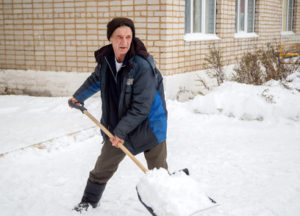This article first appeared in the January/February 2017 edition of YEG Fitness.
Snow shovelling. A Canadian right of passage? Canada’s unofficial winter sport? Love it or hate it, nearly all of us (usually begrudgingly) have picked up a shovel at one point to move the white stuff off our sidewalks and driveways. As a form of physical activity, snow shovelling places considerable demand on the body’s cardiovascular and musculoskeletal system. As a result, many individuals who shovel snow become injured.

A study published in 2011 by the American Journal of Emergency Medicine found nearly 12000 people per year are treated in hospital emergency departments in the United States for snow shovelling related injuries. Researchers found that soft tissue injuries are the most common reason for hospital admission (55%), 34% of which are cited to be in the lower back. Slips and falls (20%), being hit by a snow shovel (15%), and cardiac related emergencies (7%) are also among the list of related injuries. Furthermore, approximately two-thirds of all injuries involved men.
Should we toss out our snow shovels and replace them with snow blowers? Not necessarily. By following a few simple snow shovelling tips, you can decrease your chances of getting injured.
Step 1: Choose The Right Shovel
Avoid straight shaft shovels. Straight shaft shovels require users to repeatedly bend and twist to move snow. This causes shear and compression on the lower back and spine, a common cause of injury. Choose a curved shaft shovel instead. The curved shaft decreases the need for forward bending and takes more stress off the lower back when lifting snow compared to a straight shaft shovel. A correct shovel length should allow you to have your knees slightly bent and your back nearly straight at the start of your shovel stroke. You can also help make the job easier by choosing a shovel made with a lightweight material and applying lubricant to the shovel blade to prevent snow from sticking to it.
Step 2: Prepare Your Body
Snow shovelling requires co-ordinated, repetitive use of the body’s major muscles groups (legs, arms, chest, upper back). Ensuring these muscle groups are adequately trained prior to snow shovelling helps to avoid injury. Functional exercises including squats, dead lifts, standing chest press, bent over rows, and bicep curls are all great exercises to help prepare for the demands of shovelling. Not sure where to start? Contact a healthcare provider who is trained in functional movement screens and exercise prescription to ensure your body moves at its best.
Snow shovelling also challenges your cardiovascular system. One study found that the heart rate of sedentary men exceeded the upper limits recommended for aerobic exercise after just 2 minutes of shovelling. Since snow shovelling is typically done in short intense bursts, ensure your cardiovascular system can meet the demands by incorporating interval training into your cardiovascular exercise routine. Sedentary, deconditioned individuals should also exercise caution when snow shovelling, as they are at a higher risk for heart failure with intense cardiovascular activity. In this case, discuss your current health status with your physician or health care provider before attacking a big snowfall.
Step 3: Use Proper Form
As with any exercise, proper form is key to prevent injury. Grip the shovel with your hands at least 12 inches apart for more leverage. Push the snow as you shovel. When lifting snow, squat down with knees apart and keep your back straight. Focus on using your legs and glutes to lift the snow laden shovel without bending forward at the waist. Step into the direction you are throwing snow, keeping the load close to your body. Throw the snow in front of you as opposed to twisting your body and throwing it to the side.
Additionally, keep well hydrated while shovelling, take frequent breaks and pace yourself. If possible, shovel in shifts as the snow falls rather than waiting until a heavy pile has built up. Get help with the shovelling! Chat with your neighbours or family members in order to divide the load. Importantly, if you feel any cardiovascular warning signs such as lightheadedness, nausea, sudden shortness of breath, chest pain/tightness that may spread to the neck, jaw back or arms, heed these warnings and get emergency assistance.
If you regularly need to shovel a lot of snow, you may want to trade the snow shovel in for a snow blower, but beware that snow blowing comes with its own set of injury risks. Or, if you are elderly, have a pre-existing medical condition, or are not in good enough physical shape to regularly shovel, there is always the option of hiring someone else to do the job.”
By following these simple tips, you can allow your body to work smarter, not harder, and decrease your chances of suffering a snow shovelling related injury during our long winter season.
— Miles Morgan, MScPT, MPA, is a Physiotherapist and owner of REP Physio.
References:
- D. Watson et al., “Snow shovel-related injuries and medical emergencies treated in US EDs, 1990 to 2006.” AJEM (2011) 29.
- Ibid.
- R. Lesinson et al., “Influence of snow shovel shaft configuration on lumbosacral biomechanics during a load-lifting task.” Applied Ergonomics (2014) 45.
- D. Watson et al.
